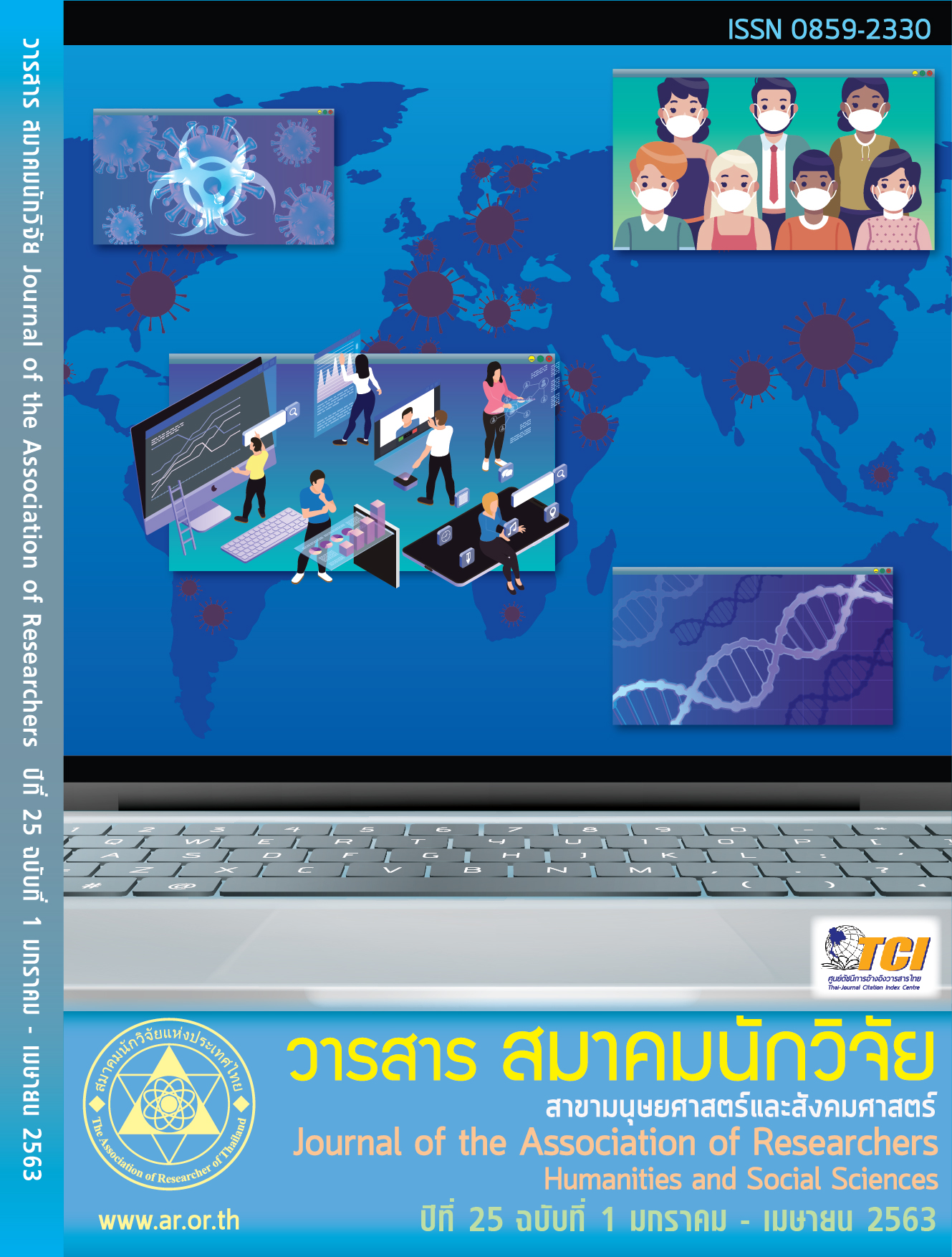ภาวะผู้นำที่รับผิดชอบต่อสังคมที่ส่งผลต่อความไว้วางใจของพนักงาน ในบริษัทที่มีการพัฒนาอย่างยั่งยืนของประเทศไทย
Main Article Content
บทคัดย่อ
การศึกษาครั้งนี้มีวัตถุประสงค์ 1) เพื่อศึกษาความสัมพันธ์ระหว่างภาวะผู้นำที่รับผิดชอบต่อสังคม ความรับผิดชอบต่อสังคมขององค์กรและความไว้วางใจในองค์กรของพนักงานในบริษัทที่มีการพัฒนาอย่างยั่งยืนของประเทศไทย และ 2) เพื่อศึกษาอิทธิพลระหว่างภาวะผู้นำที่รับผิดชอบต่อสังคม ความรับผิดชอบต่อสังคมขององค์กรและความไว้วางใจในองค์กรของพนักงานในบริษัทที่มีการพัฒนาอย่างยั่งยืนของประเทศไทย กลุ่มตัวอย่างเป็นพนักงานจำนวน 400 คน จากบริษัทที่มีการพัฒนาอย่างยั่งยืนในประเทศไทย สุ่มตัวอย่างแบบหลายขั้นตอนได้แก่ แบบโควตาและแบบสะดวก ทำการวิเคราะห์ข้อมูลทางสถิติด้วยค่าเฉลี่ย ส่วนเบี่ยงเบนมาตรฐาน สัมประสิทธิ์สหสัมพันธ์เพียร์สัน และตัวแบบสมการโครงสร้าง
ผลการวิจัยพบว่า ระดับภาวะผู้นำที่รับผิดชอบต่อสังคม ความรับผิดชอบต่อสังคมขององค์กร และความไว้วางใจของพนักงานในองค์กรที่มีการพัฒนาอย่างยั่งยืนมีค่าเฉลี่ยอยู่ในเกณฑ์สูง ค่าสัมประสิทธิ์สหสัมพันธ์ระหว่างทุกคู่ตัวแปรมีความสัมพันธ์กันอย่างมีนัยสำคัญ จากตัวแบบสมการโครงสร้าง ภาวะผู้นำที่รับผิดชอบต่อสังคมมีอิทธิพลทางตรงต่อความรับผิดชอบต่อสังคมขององค์กรอย่างมีนัยสำคัญและมีค่าความแปรปรวนที่ถูกทำนายโดยภาวะผู้นำที่รับผิดชอบต่อสังคมอยู่ในระดับสูงมาก นอกจากนั้นภาวะผู้นำที่รับผิดชอบต่อสังคมมีอิทธิพลทางอ้อมต่อความไว้วางใจของพนักงานในองค์กรผ่านความรับผิดชอบต่อสังคมขององค์กรอย่างมีนัยสำคัญ โดยมีค่าความแปรปรวนที่ถูกทำนายโดยภาวะผู้นำที่รับผิดชอบต่อสังคมอยู่ในระดับปานกลาง สุดท้ายความรับผิดชอบต่อสังคมขององค์กรมีอิทธิพลทางตรงต่อความไว้วางใจของพนักงานในองค์กรอย่างมีนัยสำคัญ โดยผลจากการทดสอบพบว่าแบบจำลองตามทฤษฏีมีความสอดคล้องกับข้อมูลเชิงประจักษ์
Article Details
บทความที่ปรากฏในวารสารนี้ เป็นความรับผิดชอบของผู้เขียน ซึ่งสมาคมนักวิจัยไม่จำเป็นต้องเห็นด้วยเสมอไป การนำเสนอผลงานวิจัยและบทความในวารสารนี้ไปเผยแพร่สามารถกระทำได้ โดยระบุแหล่งอ้างอิงจาก "วารสารสมาคมนักวิจัย"
References
พรชัย ศักดานุวัฒน์วงศ์. (2558). ความสัมพันธ์เชิงสาเหตุระหว่างภาวะผู้นำที่รับผิดชอบต่อสังคมและประสิทธิผลขององค์การในตลาดหลักทรัพย์แห่งประเทศไทย. วิทยานิพนธ์ปริญญาปรัชญาดุษฎีบัณฑิต, คณะบริหารธุรกิจ มหาวิทยาลัยเกษตรศาสตร์.
พรชัย ศักดานุวัฒน์วงศ์และพิพัฒน์ นนทนาธรณ์. (2558). การพัฒนาเครื่องมือวัดภาวะผู้นำที่รับผิดชอบต่อสังคม. วารสารสมาคมนักวิจัย, 20(3), 111-125.
พิริยาภรณ์ อันทอง และ ศุภกร เอกชัยไพบูลย์. (2559). Checklist พิชิตธุรกิจยั่งยืน. กรุงเทพฯ: ศูนย์พัฒนาความรับผิดชอบต่อสังคม ตลาดหลักทรัพย์แห่งประเทศไทย.
รายงานการพัฒนาอย่างยั่งยืน. (2559). บริษัทปูนซีเมนต์ไทย จำกัด (มหาชน), บริษัทธนาคารกสิกรไทย จำกัด (มหาชน) และบริษัท ปตท.จำกัด (มหาชน).
วรนาท สามารถ. (2557). บุพปัจจัยและความแตกต่างของความเชื่อถือไว้วางใจในทีมและความผูกพันต่อองค์การระหว่าง พนักงานในทีมดั้งเดิมและทีมเสมือนจริง: กรณีศึกษา อุตสาหกรรมสายการบิน. วารสารวิชาการอุตสาหกรรมศึกษา, 8(2): 45-56.
วิเชียร เกตุสิงห์. (2538). ค่าเฉลี่ยและการแปลความหมาย: เรื่องง่าย ๆ ที่บางครั้งก็พลาดได้. ข่าวสารวิจัยทางการศึกษา, 18 (3): 8 - 11.
สุมิตตา สว่างทุกข์ และ ปาริชาติ ทาโน. (2558). การศึกษาการตระหนักรู้ในพฤติกรรมเสี่ยงทางเพศกับพฤติกรรมเสี่ยงทางเพศของนักเรียนวัยรุ่น. วารสารเกื้อการุณย์, 22(2). 41-56.
References
Carroll, A. B. 1979. A three-dimensional conceptual model of corporate performance. The Academy of Management Review, 4(4): 497-505.
______. 1991. The pyramid of corporate social responsibility: Toward the moral management of organizational stakeholders. Business Horizons, 34(4): 39-48.
Chomeya, Rungson. (2010). Quality of psychology test between likert scale 5 and 6 points. Journal of Social Sciences, 6(3): 399-403.
Cochran, W. G. 1963. Sampling techniques, (2nd ed.). New York: John Wiley and Sons, Inc.
Dugan, J. P. (2006). SRLS-Rev 2: The second revision of SRLS. College park: National Clearinghouse for Leadership Programs.
Fornell, C., & Larcker, D. F. (1981). Evaluating structural equation models with unobservable variables and measurement error. Journal of Marketing Research, 10(1), 39-50.
Gond, J-P., El-Akremi, A., Igalens, J., & Swaen, V. (2010). Corporate social responsibility influence on employees. In J. Moon (Ed.). ICCSR Research Paper Series No.54-2010. (pp. 1-45). Nottingham: Cambridge University Press.
Hansen, S. D., Dunford, B. B.., Boss, A. D.., Boss, R. W.., & Angermeier, I. (2011). Corporate social responsibility and the benefit of employee trust: a cross-disciplinary perspective.” Journal of Business Ethics, 102 (1): 29-45.
Hair, J.F. Jr., Anderson, R. E., Tatham, R. L., & Black, W. C. (1998). Multivariate data analysis. (5th ed.), Upper Saddle River, NJ: Prentice Hall.
Holmes-Smith, P. (2001). Introduction to structural equation modelling using LISREL. Perth,ACSPRI-Winter training program.
Hooper, D., Coughlan, J., & Mullen, M. R. (2008). Structural equation modelling: Guidelines for determining model fit. Journal of Business Research Methods, 6(1): 53–60.
Kline, R. B. (2005). Principles and practice of structural equation modeling.(2nd ed.). NY: Guilford Press.
Leech, N. L., Barrett, K. C., & Morgan, G. A. (2005). SPSS for intermediate statistics use and interpretation. Mahwah, NJ: Lawrence Erlbaum.
Maak, T., & Pless, N. M. (2006). Responsible Leadership. New York: Routledge.
Maak, T., & Pless, N. M. (2009). Business leaders as citizens of the world. Advancing humanism On a global scale. Journal of Business Ethics, 88(3), 537-550.
Maignan, I. and O. C. Ferrell. 2001. Antecedents and benefits of corporate citizenship: An investigation of French businesses. Journal of Business Research, 51(1): 37-51.
Mayer, R. C., Davis, J. H., & Schoorman, F. D. (1995). An integrative model of organizational trust. Academy of Management Review, 20: 709 –734.
Melé (2008). Corporate Social Responsibility Theories. In A. Crane, A. McWilliams, D.
Matten, J. Moon & D. Siegel (eds.). The Oxford Handbook of Corporate Social Responsibility. Oxford: Oxford University Press.
Nyhan, R. C., & Marlowe, H. A. (1997). Development and psychometric properties of the organizationaltrust inventory. Evaluation Review, 21(5):614-635.
Nunnally, J. C. (1978). Psychometric theory. (2nd ed.). New York, NY: McGraw-Hill.
Robbins, S. P. (2005). Essentials of 0rganizational behavior. (8th ed). New Jersey. Pearson Prentice Hall.
Rousseau, D. M. et al. (1998). Not so different after all: a cross-discipline view of trust. Academy of Management Review, 23(3):393–404.
Sendjaya, S., Sarros, J.C., & Santora, J.C. (2008). Defining and measuring servant leadership behavior in Organizations. Journal of Management Studies, 45(2):402-24.
Sendjaya, S., & Pekerti, A. (2010). Servant leadership as antecedent of trust in organizations. Evaluation Leadership & Organization Development Journal, 31(7):643-663.
Shaw, F.B. (1997). Trust in balance. San Francisco: Jossey-Bass. Tabachnick, B. G., & Fidell, L. S. (2007). Using Multivariate Statistics. (5th ed.). New York: Allyn and Bacon.
Tourigny, L., Han, J., Baba, V. V., & Pan, P. (2017). Ethical leadership and corporate social responsibility in China: A multilevel study of their effects on trust and organizational
citizenship behavior. Journal of Business Ethics, https://doi.org/10.1007/s10551-017- 3745-6.United Nations. (2018). Sustainable development goals (Online). https://www.un.org/sustainabledevelopment/sustainable-development-goals/, March 22, 2019.
Voegtlin, C. (2011). Development of a scale measuring discursive responsible leadership. Journal of Business Ethics, 98 (S1): 57-73.
Voegtlin, C., Patzer, M., & Scherer, A. G. (2012). Responsible leadership in global business: A new approach to leadership and its multi-level outcomes. Journal of Business Ethics, 105(1): 1-16.
Waldman, D. A. (2007). Best practices in leading at strategic level: A social responsibility perspective.In J. A. Conger & E. R. Ronald E (Eds.). The practice of leadership: Developing the next generation of leaders (pp. 224-243). San Francisco: Jossey Bass.
Wagner, W. (2006). The social change model of leadership: A brief overview. Concept & Connections, 15(1), 1-19.
Translated Thai References
Katesing, W. (1995). Mean and interpretation: Simple things that sometimes can be missed.. Journal of Educational Research, 18(3): 8 - 11.
Sakdanuwatwong, P. (2015). Causal relationship between socially responsible leadership and organizational effectiveness in the stock exchange of Thailand. Thesis Doctor of Philosophy, Faculty of Business Administration. Kasetsart University. (in Thai).
Sakdanuwatwong, P., & Nonthanathorn, P. (2015). Development of a scale measuring socially responsible leadership. Journal of the Association of Researchers, 20(3), 111-125. (in Thai).
Samart, W. (2014). Antecedents and Differences between Trust in Team and Organization Engagement between Employees Working in Traditional Team and Virtual Team: A Case Study of companies in Aviation Industry. Journal of Industrial Education, 8(2), 46-56. (in Thai).
Sawangtook, S., & Thano, P. (2015). The Study of the Awareness of Sexual Risk Behaviorsand Sexual Risk Behaviors of Adolescent Students. Kuakarun Journal of Nursing, 22(2). 41-56. (in Thai).
Sustainability Report. (2016). SCG., Kbank and PTT (in Thai).
The Stock Exchange of Thailand. (2016). New Release, Volume 77/2016. (in Thai)
Unthong, P. & Ekachaiphaibul, S. (2016). Checklist Sustainable Organization.Bangkok: SR Center. (in Thai)

